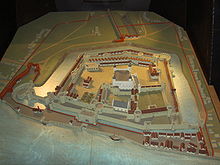The Tower Hill Postern was a small fortified entrance (postern) at the eastern terminal point to the London Wall, at the junction of the Wall and the Tower of London moat. The size of the gateway indicates that it was suitable for pedestrians and horsemen but not wide enough to accommodate wagons, carts or carriages.


Antecedent gateway
There is no evidence for a gateway on the site earlier than the building erected by Edward I around 1297-1308, and no reason for there to have been a gateway there before the expansion of the Tower of London. There are a number of circumstantial arguments including arguments based on road alignments, records of parochial disputes and indirect references by William Fitzstephen to indicate that there may have been a gateway further south that was replaced when much of the wall was demolished as part of the expansion of the Tower.
History
The Tower of London moat was dug in around 1270 as part of a scheme to extend the Tower, and part of the London Wall was demolished to make room for the expanded Tower and Moat. The postern at the edge of the moat, at the wall's new terminal point was probably built soon after, most likely in the period 1297-1308. The southern tower, which was built from Caen stone, partially collapsed in either 1431 or 1440, sliding vertically down three metres into the Tower Moat. The tower remained standing and though functionally impaired remained in use. There was a subsequent degree of re-building.
Structure
The southern tower included a ground floor and a cellar, thought to have been reached by a ladder. The cellar had a window overlooking the moat. The remains of a stairwell and a portcullis chase indicate that there was an upper floor and perhaps also a parapet on the roof. Nothing is known for certain about the tower north of the gateway except the information that can be gleaned from cartographic sources, all of which postdate the collapse of the southern tower. Some believe that the northern and surviving southern towers existed at the same time, while others think the northern tower was erected subsequently, to compensate for the loss of the southern tower.
Setting
The postern was situated in the Tower Liberty, an area outside the jurisdiction of the City of London, which included the Tower itself and the surrounding areas. The area was under the control of the Tower in order that the defensibility of the Tower was not compromised by development leading up to the edge of the castle and its moat. The Tower Liberty is still outside the authority of the City, now forming part of the London Borough of Tower Hamlets.
Remains
The foundations of the southern tower, which sunk into the moat, were excavated in 1979 and can be seen in the Tower Hill underpass.
51°30′34″N 0°04′33″W / 51.50943°N 0.07595°W / 51.50943; -0.07595
References
- Parishes, Churches, Wards and Gates in Eastern London. Jeremy Haslam.
- The medieval postern gate by the Tower of London, David Whipp, Museum of London Archaeology Service, Section 3.2
- The Tower of London, the Official Illustrated History
- London Wall Walk Guide https://www.colat.org.uk/_assets/doc/london-wall-walk-guide.pdf
- The medieval postern gate by the Tower of London, David Whipp, Museum of London Archaeology Service, Section 2.1
- London Wall Walk Guide https://www.colat.org.uk/_assets/doc/london-wall-walk-guide.pdf this source uses the date 1440
- The medieval postern gate by the Tower of London, David Whipp, Museum of London Archaeology Service, Section 2.2 discusses the weak sources. Stow used the date 1440 while the Chronicle of William Gregory is the ultimate source for 1431. The MoLaS guide suggests there may have been more than one subsidence event
- The medieval postern gate by the Tower of London, David Whipp, Museum of London Archaeology Service, Section 2
- The medieval postern gate by the Tower of London, David Whipp, Museum of London Archaeology Service, Section 3.3
- Tower of London Local Setting Study, 2010, sec 4.1